Application of High-Precision Magnetic Measurement in the Exploration of Deep Fluorite Deposits in Ore Concentrations
Abstract
1. Introduction
2. Geological Overview of the Study Area
2.1. Stratigraphic Characteristics
2.2. Tectonic Characteristics
2.3. Magmatic Rock Characteristics
2.4. Fluorite Mine Characteristics
2.5. Geophysical Characteristics
3. Interpretation and Inference of Aeromagnetic Anomalies
3.1. Magnetic Anomaly Characteristics
3.2. Delineation of Concealed Rock Masses
3.3. Inference of Fault Tectonic Zones
3.4. Analysis of Magnetic Anomaly Characteristics of Known Fluorite Mines
4. Target Area Delineation
4.1. Geological Ore-Controlling Model
4.2. Magnetic Anomaly Model
4.3. Borehole Verification
5. Discussion
5.1. Zonation of Negative Magnetic Anomalies
5.2. Tectonic Ore-Controlling Mechanism and Deep Hydrothermal Activities
5.3. The Contribution of Concealed Rock Masses to Mineralization
5.4. The Applicability and Limitations of High-Precision Magnetic Methods
5.5. Implications for Regional Prospecting Strategies
6. Conclusions
Author Contributions
Funding
Data Availability Statement
Acknowledgments
Conflicts of Interest
References
- Duan, Z.-P.; Jiang, S.-Y.; Su, H.-M.; Zhu, X.-Y.; Zou, T.; Cheng, X.-Y. Trace and Rare Earth Elements, and Sr Isotopic Compositions of Fluorite from the Shihuiyao Rare Metal Deposit, Inner Mongolia: Implication for Its Origin. Minerals 2020, 10, 882. [Google Scholar] [CrossRef]
- Hongyi, M.; Hongli, L.; Linbing, Z.; Chuangkai, Z.; Li, M.; Jian, Y.; Mu, Z.; Juntao, S.; Lixia, W. Deposit characteristics and prospecting potential of the Heyu fluorite ore con-centration area in western Henan Province. Geol. Explor. 2023, 59, 557–569. [Google Scholar]
- Shen, R.-F.; Hu, Y.-J.; Wang, Z.-Q.; Wang, J.-T.; Li, M.-F.; Dou, G.-M. Geological Characteristics and Genesis of Guogou Fluorite Deposit in Lu-anchuan County, Henan Province. China Non-Met. Miner. Ind. 2024, 1, 47–50. [Google Scholar]
- Guo, J.; Cheng, B.; Wang, X. Application of gravity survey on prospecting prediction in gold exploration district Xiong’ershan srea.Henan. Miner. Resour. Geol. 2021, 35, 727–734. [Google Scholar] [CrossRef]
- Han, B.-B.; Shang, P.-Q.; Gao, Y.-Z.; Jiao, S.; Yao, C.-M.; Zou, H.; Li, M.; Wang, L.; Zheng, H.-Y. Fluorite Deposits in China: Geological Features, Metallogenic Regularity, and Research Progress. China Geol. 2020, 3, 473–489. [Google Scholar]
- Liu, H.T.; Yu, H.T.; Sun, Y.; Jiang, W.Y.; Yang, G.D.; Wang, M.W.; Wang, J.W. Formation and Differential Enrichment of Oil and Gas on Multiple Types of Slopes in Rifted Basins: Taking the Bohai Bay Basin as an Example, China. Acta Petrol. Sin. 2022, 38, 2697–2708. [Google Scholar] [CrossRef]
- Zhu, G.-B.; Liu, G.-F.; Yao, X.-N.; Yang, Z.-J. Metallogeny and mineral resource prospecting in the Pb-Zn-Ag-Au-Mo polymetallic ore belt of eastern Qinling. J. Earth Sci. Environ. 2005, 2701, 44–52. [Google Scholar]
- Zhang, K.-T.; Bai, D.-S.; Li, J.-S.; Liu, J.-F.; Xu, D.; Su, Y.-Y.; Fan, K. Research progress in the geological characteristics and material sources of fluorite deposits in the Heyu-Checun area, western Henan Province. Geophys. Geochem. Explor. 2022, 46, 787–797. [Google Scholar] [CrossRef]
- Huang, C.; Zhao, W.; Zhang, Z.; Xu, B.; Chen, S.; Chen, W.; Zhang, J. Distribution Characteristics and Metallogenic Regularity of Fluorite Deposits in Henan Province. China Non-Met. Miner. Ind. 2023, 1, 41–46+54. [Google Scholar]
- Yang, S.; Feng, C.; Lou, F.; Xu, D. Characteristics of ore-forming fluids and ore-forming model of the Longping fluorite deposit in southern Jiangxi Province. Acta Geol. Sin. 2022, 96, 3886–3900. [Google Scholar] [CrossRef]
- Tang, L.; Zhang, S.; Wang, L.; Pei, Q.; Fang, Y.; Cao, H.; Zou, H.; Yin, S. Exploration of concealed fluorite deposit in shallow overburden areas: A case study in Elimutai, Inner Mongolia, China. Earth Sci. Front. 2021, 28, 208–220. [Google Scholar] [CrossRef]
- Fang, G.; Wang, D.; Chen, Y.; Huang, F.; Wang, Y.; Wu, J.; Hu, S. Metallogenic regularities and genesis of the fluorite deposits in Nanling region. Acta Geol. Sin. 2020, 94, 161–178. [Google Scholar] [CrossRef]
- Wang, J.; Zhu, J.; Li, J.; Shang, P.; Xiong, X.; Gao, Y.; Zhang, H.; Zhang, Y.; Qi, C.; Zhu, Y. Prediction model and resource potential assessment of fluorite deposits in China. Earth Sci. Front. 2018, 25, 172–178. [Google Scholar] [CrossRef]
- dos Santos, F.P.; Leão-Santos, M.H.; Borges, W.R.; Borges, P.C. Geophysical Methods Applied to the Mineraliza-tion Discovery of Rare-Earth Elements at the Fazenda Buriti Alkaline Complex, Goiás Alkaline Province, Brazil. Minerals 2024, 14, 1163. [Google Scholar] [CrossRef]
- Li, W.Z.; Wang, F.K. Geophysical characteristics and ore-hunting prospect of Shizhaipu iron mineralization area in Suiping county, Henan province. Resour. Surv. Environ. 2011, 32, 129–136. [Google Scholar]
- Jorgensen, M.; Zhdanov, M.S.; Gribenko, A.; Cox, L.; Sabra, H.E.; Prikhodko, A. 3D Inversion and Interpretation of Airborne Multiphysics Data for Targeting Porphyry System, Flammefjeld, Greenland. Minerals 2024, 14, 1130. [Google Scholar] [CrossRef]
- Zhang, H.L.; Li, P.; Zhang, J.; Niu, Y.; Qu, Y. Geological characteristics and prospecting indications of Guojialing gold deposit in Lushi county, Henan province. World Nonferrous Met. 2019, 6, 213–215. [Google Scholar]
- Sun, F.; Qu, C.; Cao, G.; Xie, L.; Shi, X.; Luo, S.; Liu, Z.; Zhang, L.; Ma, X.; Zhou, X.; et al. Oolitic Sedimentary Characteristics of the Upper Paleozoic Bauxite Series in the Eastern Ordos Basin and Its Significance for Oil and Gas Reservoirs. Processes 2024, 12, 2123. [Google Scholar] [CrossRef]
- Zhao, W.; Huang, C.; Huang, J.; Hu, D. Geological Characteristics and Ore-controlling Factors of Feng-gang Fluorite Deposit in Queshan County, Henan Province. China Non-Met. Miner. Ind. 2022, 6, 57–60. [Google Scholar]
- Yan, J.S.; Wang, M.S.; Yang, J.C.; Xu, Y.X. Tectonic evolution of the Machaoying fault zone in western Henan and its relationship with Au-polymetallic mineralization. Reg. Geol. China 2000, 2, 166–171. [Google Scholar]
- Teng, F.; Meng, Q.L.; Xing, Y. Study on the distribution laws of the iron deposits and the features of gravi-ty-magnetic field in the southern margin of the North China Craton. North China Geol. 2021, 44, 70–76. [Google Scholar] [CrossRef]
- Huang, W.; Ma, L.Y.; Wang, D.Y. Analysis of Geological Characteristics and Prospecting Potential of the Jiaoyuan Fluorite Deposit in Song County, Henan Province. Nonferrous Met. Abstr. 2015, 30, 40–41. [Google Scholar] [CrossRef]
- Liu, J.F.; Bai, S.D.; Zhang, K.T.; Yang, D.C. Geological Charactristics and Sm-Nd Isotopic Ageou Fluorite Deposit, Western Henan Province. Mineral. Petrol. 2020, 40, 69–75. [Google Scholar] [CrossRef]
- Wang, C.; Li, K.Q.; Gao, J. Application Effect of Comprehensive Geophysical Prospecting Method in Fluorite Polymetallic Survey. Chem. Enterp. Manag. 2023, 14, 35–38. [Google Scholar] [CrossRef]
- Li, Y.H.; Chen, Y.; Zhao, J.Z. Mineralization Characteristics and Target Area Prediction of Fluorite Deposits in Biyang-Queshan Area. China Non-Met. Miner. Ind. 2023, 5, 58–63. [Google Scholar]
- Sun, Y.C.; Zhou, X.M.; Liu, Y.; Chen, S.W.; Zhang, J.; Yang, G.; Lu, Q.; Chen, Y.Z.; Zhang, H.H.; Su, F.; et al. Petrophysical Characteristics and Exploration Practice on the Deep strata of Upper Paleozoic in Songliao Basin. J. Jilin Univ. (Earth Sci. Ed.) 2022, 52, 1747–1761. [Google Scholar] [CrossRef]
- Zhang, X.; Mao, D.; Zhang, L.; Zhang, L. The Analysia of Physical characteristics in Henan Province. West Resour. 2015, 1, 146–149. [Google Scholar]
- Li, K.K.; Chen, X.L.; Shang, P.Q.; Yu, X.L.; Han, Z.K.; Wei, F.C.; Liu, Z.Z. Application of the prospecting method of geophysical and geochemical in-tegrated information in the exploration of fluorite deposits. Geol. Surv. China 2019, 6, 98–104. [Google Scholar] [CrossRef]
- Ma, G.; Georges, B.; Zhong, S.; Li, Y.; Zeng, Z. Geology and geochemistry of the Dengjiashan Zn–Pb SEDEX deposit, Qinling Belt, China. Can. J. Earth Sci. 2007, 44, 479–492. [Google Scholar] [CrossRef]
- Chen, S.; Li, Y.; Fan, F.; Xi, W.; Zhu, X.; Zhou, Y.; Xiao, F.; Xing, G. Mineralogy and Alkali Metasomatism of Tieshan Complex Body in Zhenghe County, Fujian Province, Southeastern China. Ore Geol. Rev. 2021, 139, 104432. [Google Scholar] [CrossRef]
- Zhang, G.; Tian, T.; Wang, R.; Gao, W.; Chang, Z. S, Pb isotopic composition of the Dongtangzi Pb-Zn deposit in the Fengtai ore concentration area of Shaanxi Province for tracing sources of ore-forming materials. Geol. China 2020, 47, 472–484. [Google Scholar] [CrossRef]
- Guo, P.; Wen, H.; Li, C.; Jin, J.; Lei, H. Origin and Enrichment of Borates in a Late Paleozoic Alkaline Lake-Playa Deposit, Junggar Basin, NW China. Ore Geol. Rev. 2021, 138, 104389. [Google Scholar] [CrossRef]
- Chen, M.; Lü, X.; Jiang, S.; Sun, B.; Ruan, B.; Chen, C. The Genesis of the Baguamiao Orogenic Gold Deposit Linked to Multistage Ore-Forming Processes in Triassic Tectonic Transition of South Qinling, China. Ore Geol. Rev. 2024, 166, 105964. [Google Scholar] [CrossRef]
- Zhao, H.; Wang, Q.; Li, C.; Pan, R.; Groves, D.I.; Yang, L.; Xu, J.; Deng, J. Two Episodes of Postpeak Metamorphic High- to Moderate-Temperature Orogenic Gold Mineralization at Danba, Southwest China: Timing and Fluid Source Constraints from Thermodynamic Modeling and U-Pb, Re-Os, and S Isotopes. Econ. Geol. 2024, 119, 1791–1807. [Google Scholar] [CrossRef]
- Luo, F.; Yan, J.; Zhang, S.; Liang, J.; Fu, G.; Wu, D.; Reng, G. Discussion of the W-Sn-REE Metallogenic Background in the Nanling Region of South China: Evidence from Satellite Gravity and Magnetic Data. Minerals 2024, 14, 215. [Google Scholar] [CrossRef]
- Zhang, S.; Guan, W.; Chang, S.; Meng, Q.; Dong, Y.; Chen, Q. Integrated Geophysical Prediction of Goaf and Water Accumulation in Pingshuo Dong Open-Cut Mine with Ultrashallow and High Drops. Processes 2023, 11, 1653. [Google Scholar] [CrossRef]


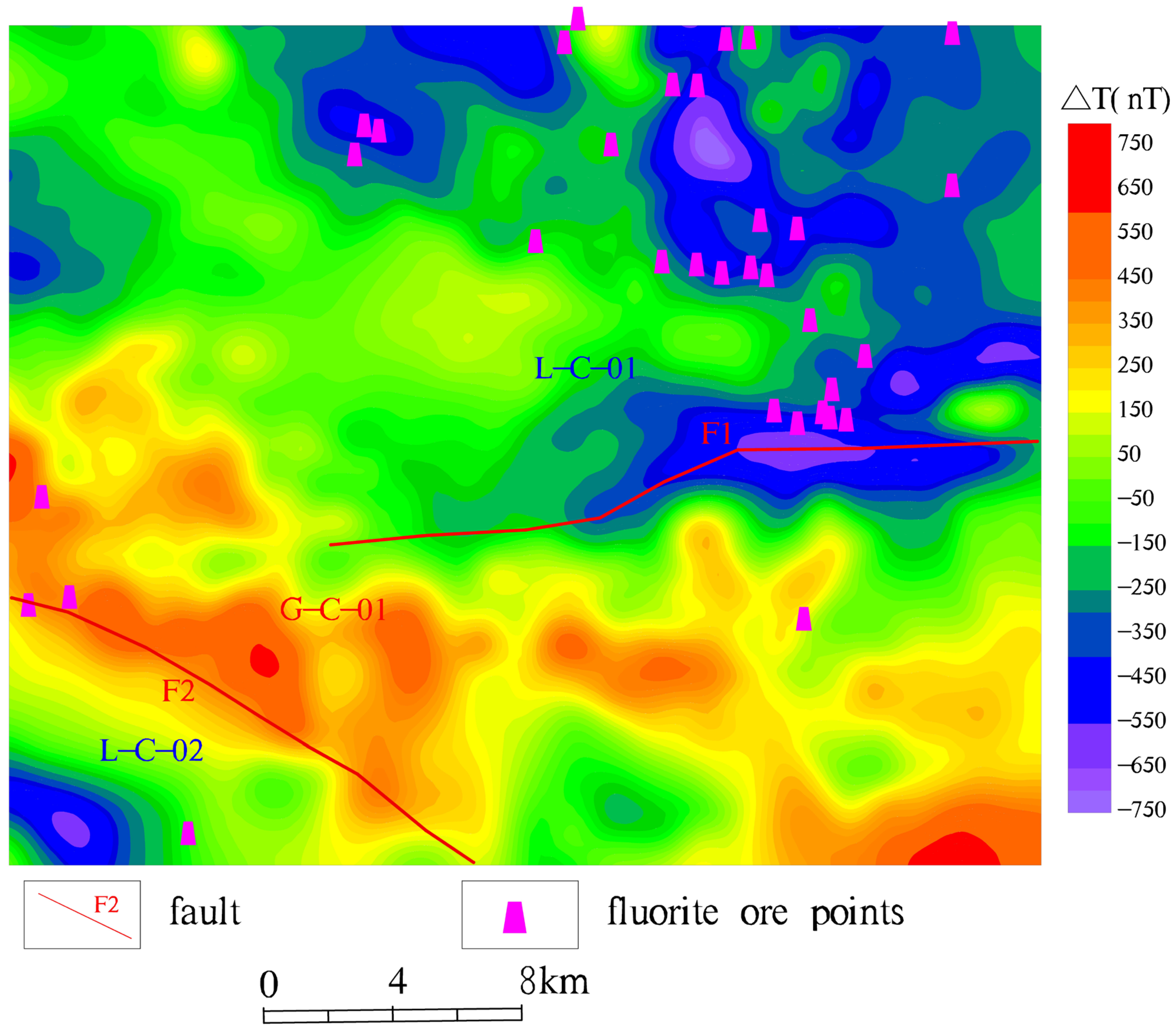

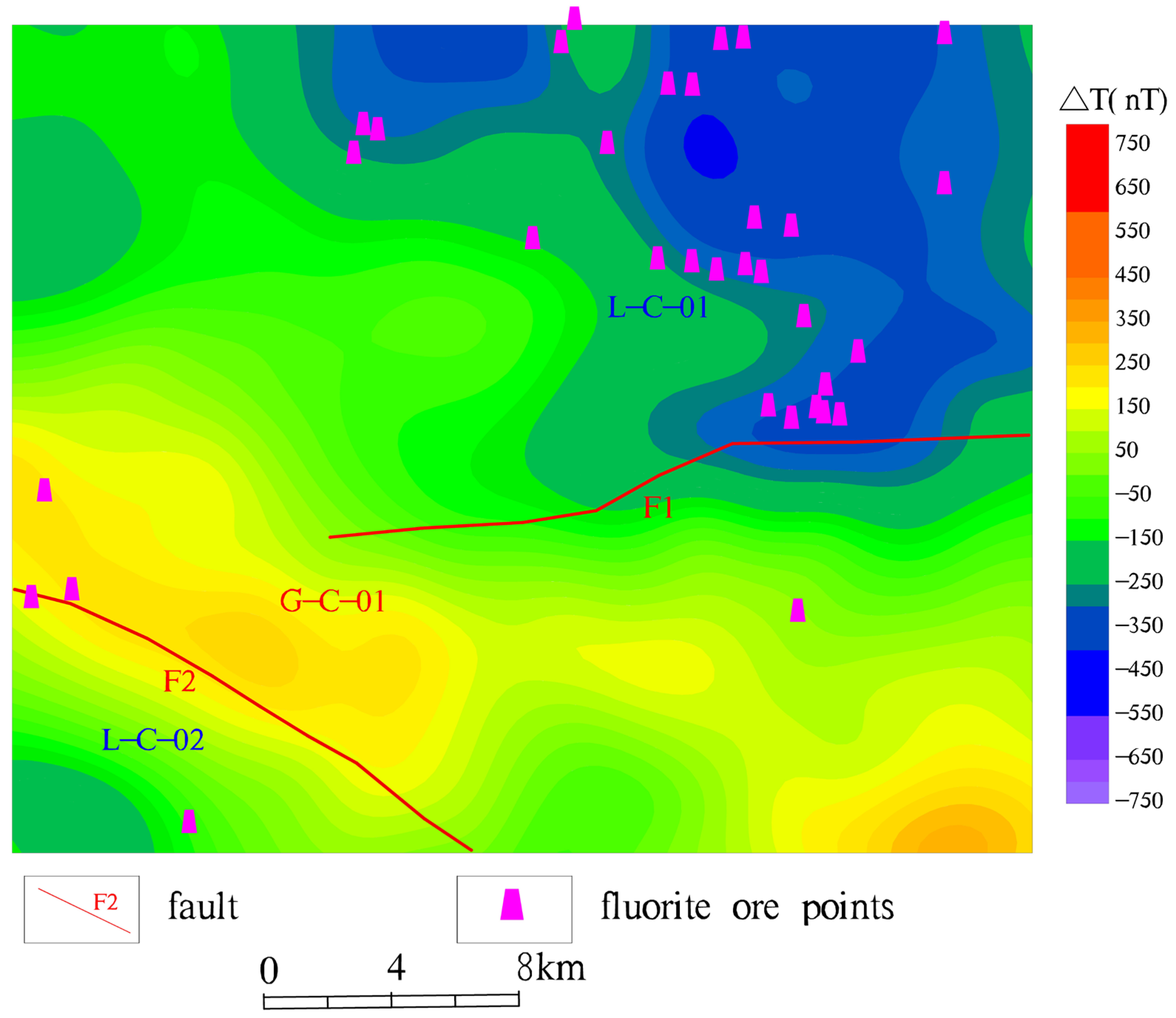
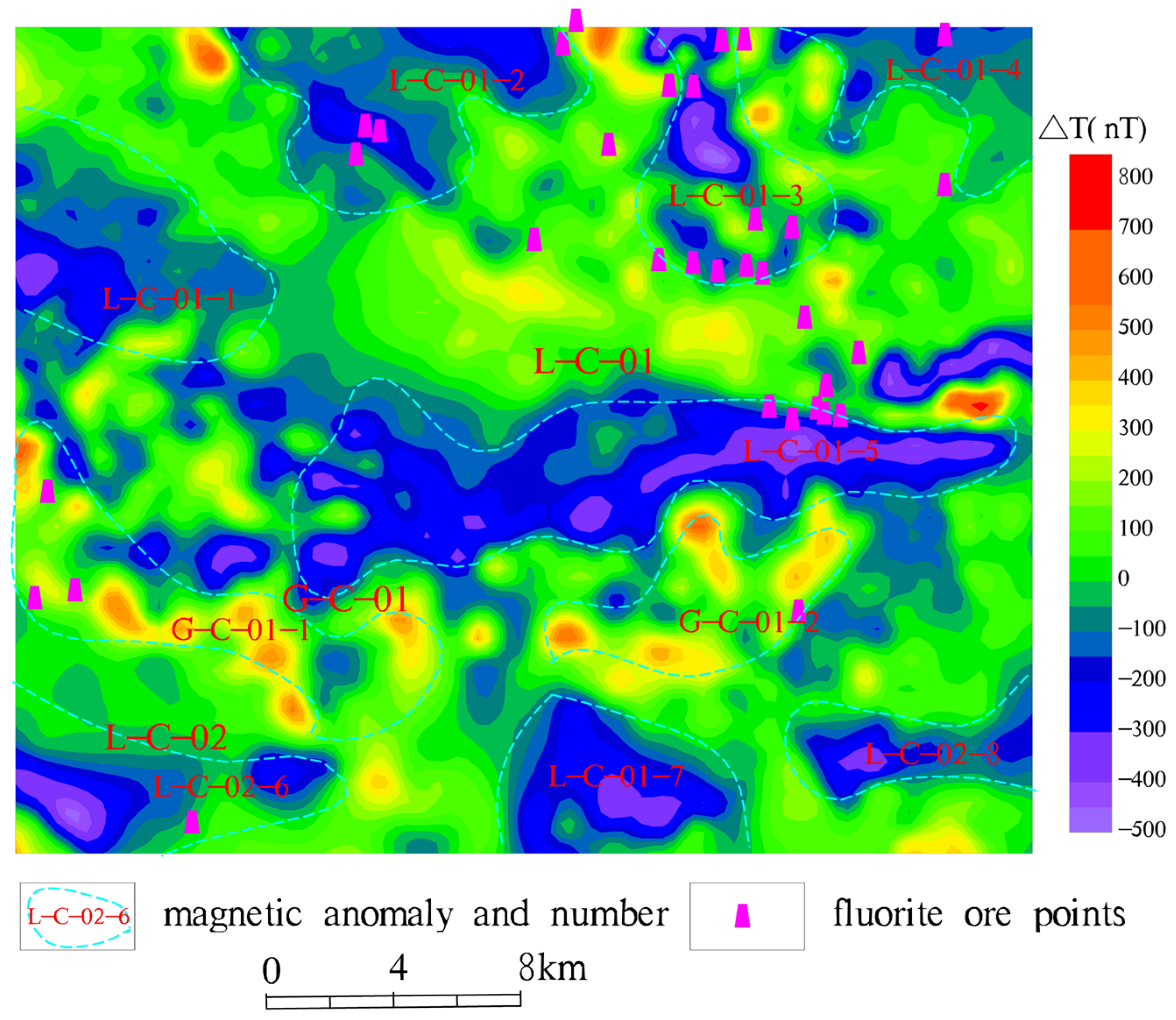
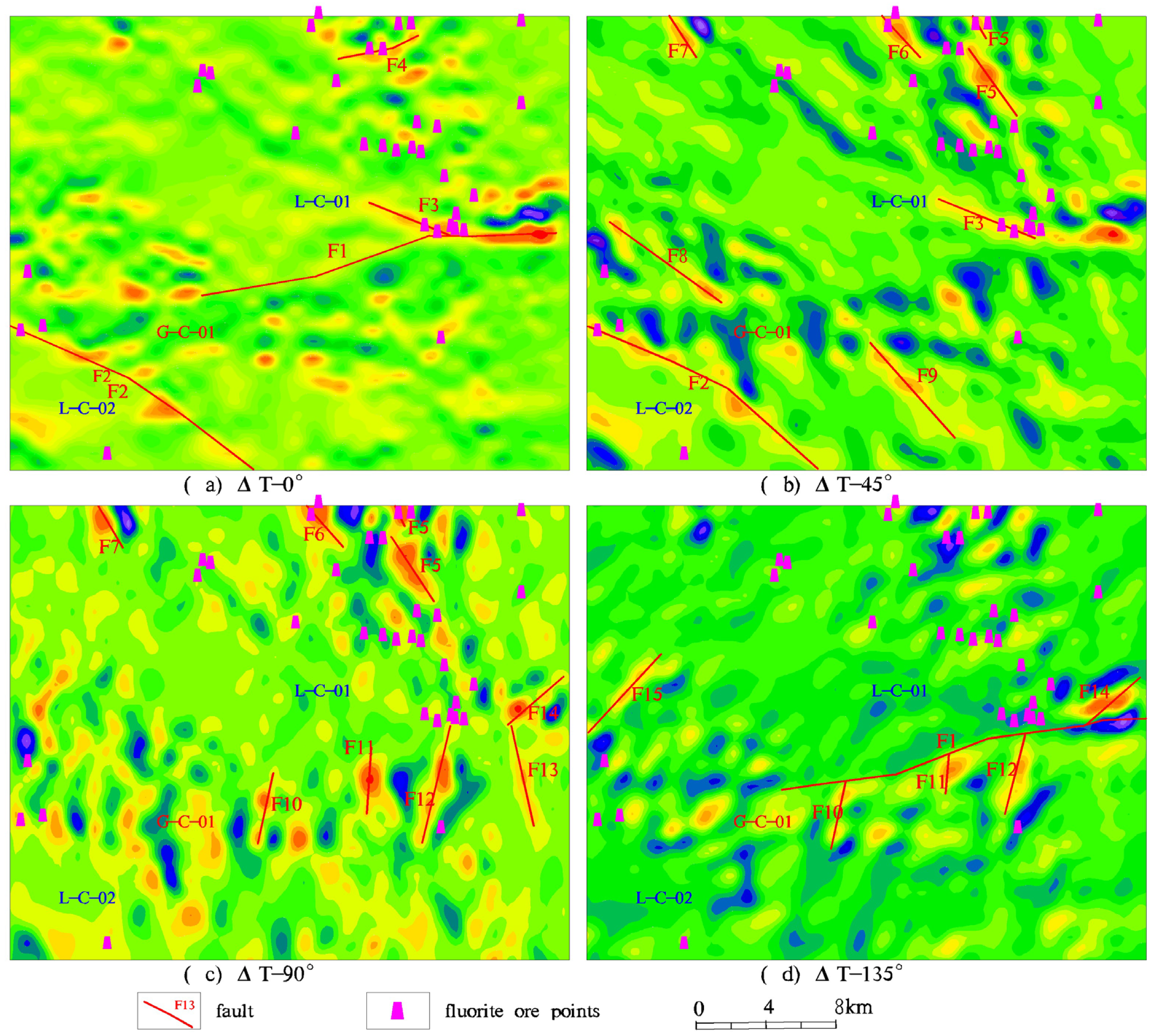
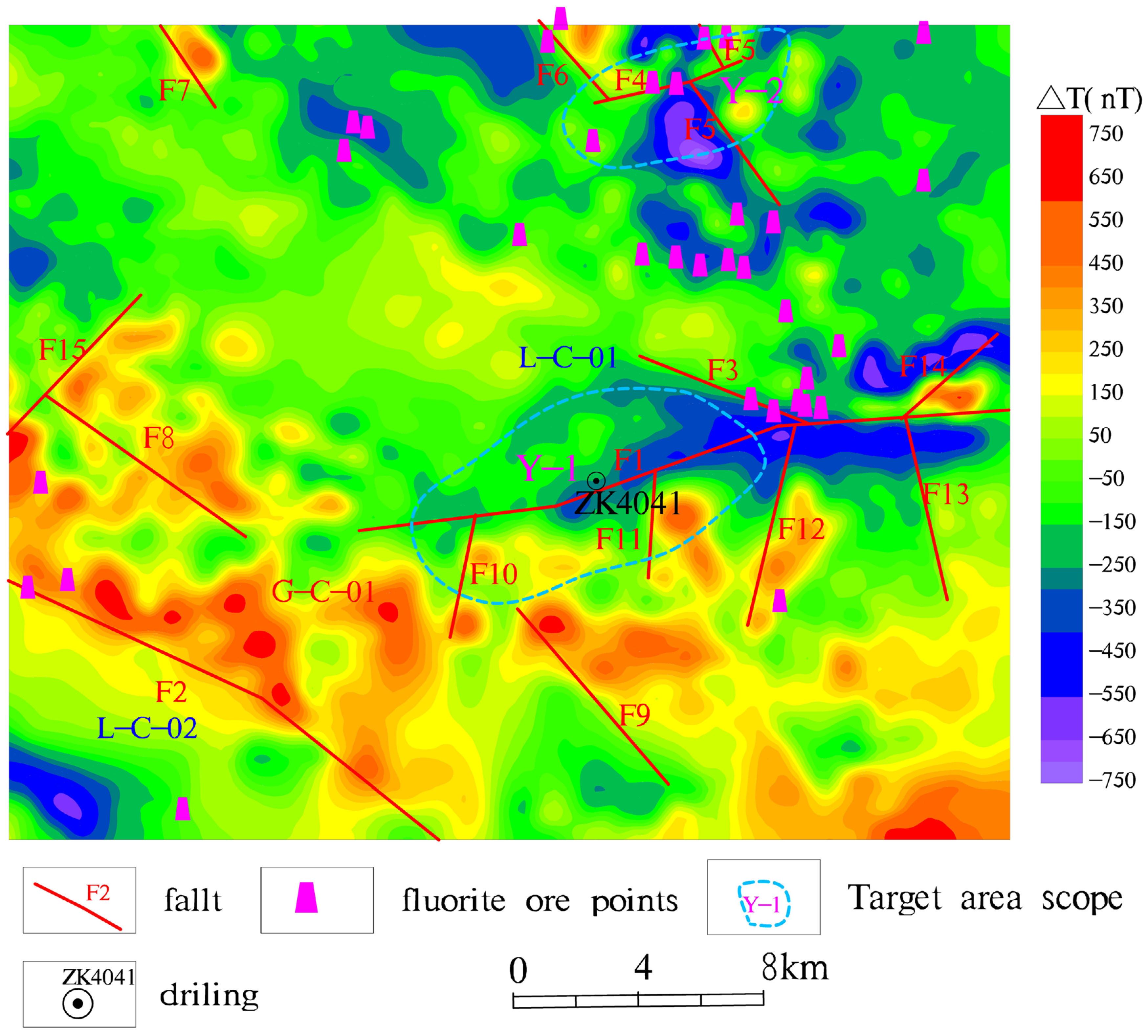

| Classification | Lithology | Average Density (g·cm−3) | Average Magnetic Susceptibility (10−5 SI) | Remanence (A/m) | |
|---|---|---|---|---|---|
| Strata | Cenozoic | Loess, sandstone, mudstone, clay | 1.98 | 21 | 9.5–28.6 |
| Neoproterozoic | Luanchuan Group: Quartzite, marble, schist, limestone, sandstone | 2.60 | 212 | 151–608 | |
| Mesoproterozoic | Guandaokou Group, Xiong’er Group: Marble, andesite, rhyolite, quartz sandstone, tuff | 2.67 | 421 | 489–2453 | |
| Intrusive Rocks | Yanshanian | Monzogranite | 2.58 | 2612 | 590–1820 |
| Syenite | 2.59 | 1370 | 806–2210 | ||
| Jinningian | Gabbro | 3.03 | 4668 | 2900–11600 | |
| Diorite | 2.80 | 1370 | 1230–4520 | ||
| Ores | Molybdenum ore | 3.19 | 2151 | 200–1230 | |
| Magnetite ore | 3.44 | 31,000 | 10,000–65,000 | ||
| Fluorite ore | 2.42 | 15.57 | <5 | ||
| Lead-zinc ore | 4.14 | 15,900 | 4500–21,000 | ||
Disclaimer/Publisher’s Note: The statements, opinions and data contained in all publications are solely those of the individual author(s) and contributor(s) and not of MDPI and/or the editor(s). MDPI and/or the editor(s) disclaim responsibility for any injury to people or property resulting from any ideas, methods, instructions or products referred to in the content. |
© 2025 by the authors. Licensee MDPI, Basel, Switzerland. This article is an open access article distributed under the terms and conditions of the Creative Commons Attribution (CC BY) license (https://creativecommons.org/licenses/by/4.0/).
Share and Cite
Zhang, Z.; Dong, Y.; Du, X.; Qi, K.; Xia, Y.; Sun, F.; Li, G. Application of High-Precision Magnetic Measurement in the Exploration of Deep Fluorite Deposits in Ore Concentrations. Minerals 2025, 15, 351. https://doi.org/10.3390/min15040351
Zhang Z, Dong Y, Du X, Qi K, Xia Y, Sun F, Li G. Application of High-Precision Magnetic Measurement in the Exploration of Deep Fluorite Deposits in Ore Concentrations. Minerals. 2025; 15(4):351. https://doi.org/10.3390/min15040351
Chicago/Turabian StyleZhang, Zhuo, Yao Dong, Xin Du, Kun Qi, Yuanyuan Xia, Fengyu Sun, and Guanghui Li. 2025. "Application of High-Precision Magnetic Measurement in the Exploration of Deep Fluorite Deposits in Ore Concentrations" Minerals 15, no. 4: 351. https://doi.org/10.3390/min15040351
APA StyleZhang, Z., Dong, Y., Du, X., Qi, K., Xia, Y., Sun, F., & Li, G. (2025). Application of High-Precision Magnetic Measurement in the Exploration of Deep Fluorite Deposits in Ore Concentrations. Minerals, 15(4), 351. https://doi.org/10.3390/min15040351







